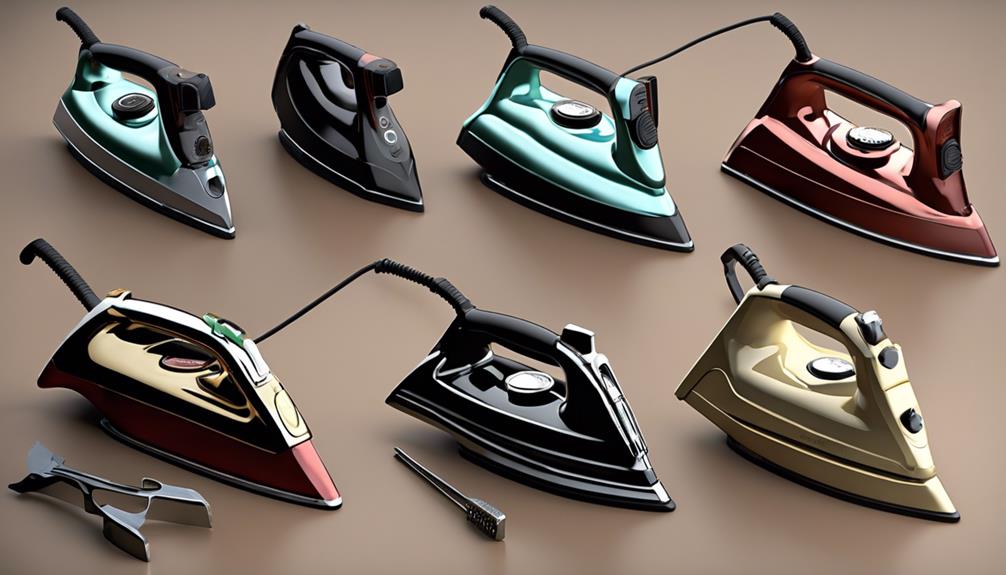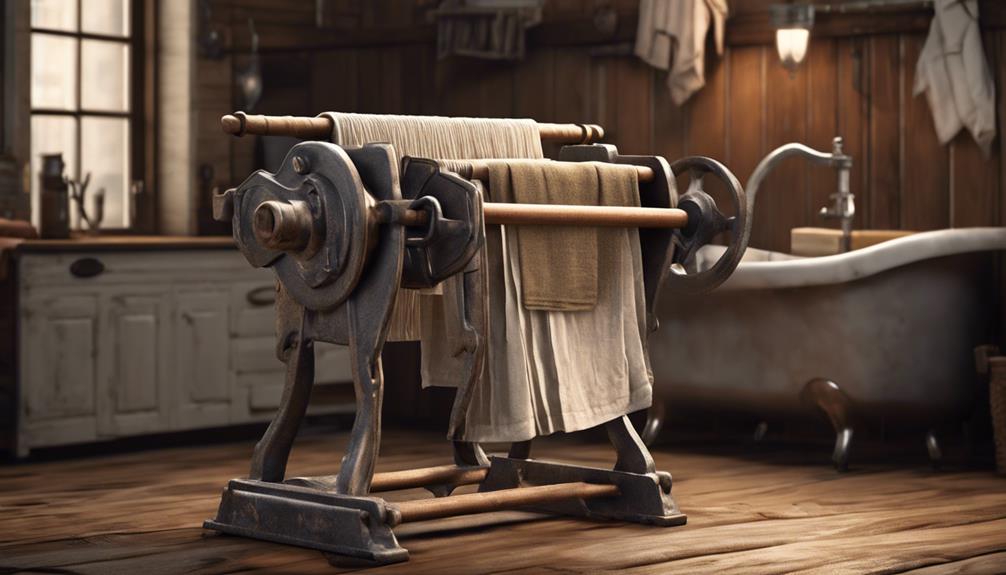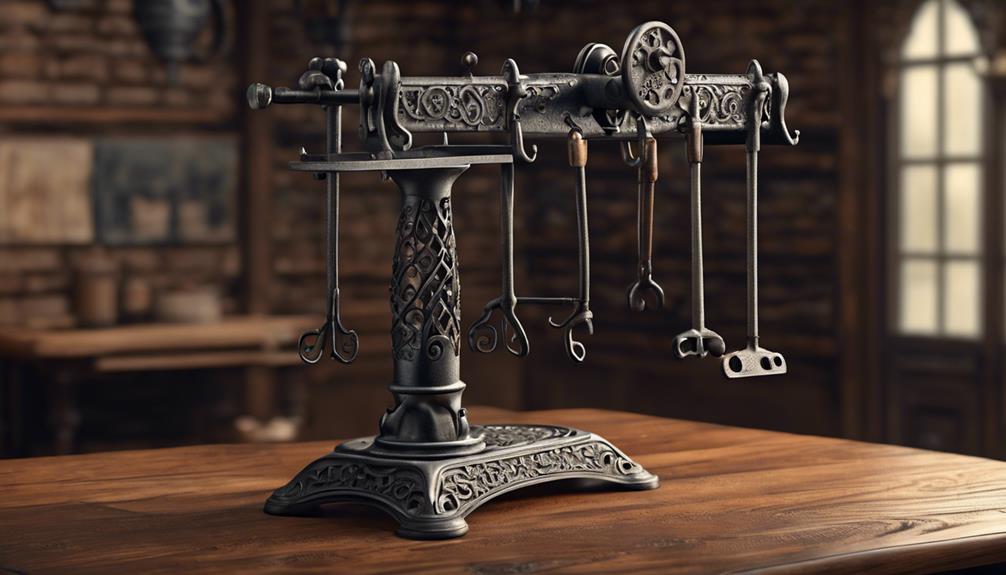If you're intrigued by antique tools for pressing clothes, you'll uncover a world of intricate craftsmanship and cultural significance. Explore the evolution of irons, from steam technology to modern fabric-specific features. Discover the diverse styles of antique ironing boards, including wooden folding and specialized sleeve boards. Vintage clothes wringers, with their manual fabric compression, offer a glimpse into historical laundry methods. Collecting these tools reveals the value placed on craftsmanship, rarity, and design. Restoring and using antique pressing tools require delicate care and historical understanding. Their history and functionality make them fascinating pieces for any enthusiast.
Key Takeaways
- Antique pressing tools include vintage irons, ironing boards, and clothes wringers.
- Value is determined by age, rarity, condition, and brand.
- Restoring antique tools involves cleaning, rust removal, and gentle maintenance.
- Exclusive finds in antique stores add uniqueness to collections.
- Handle antique tools with care to prevent damage.
Evolution of Irons

Throughout history, irons have undergone significant changes in design and functionality to meet the evolving needs of pressing clothes efficiently. From the early days of ironing techniques that involved heating irons over a fire to the more recent electric models that simplify the process, irons have played an essential role in maintaining well-pressed garments.
The introduction of steam technology revolutionized ironing, making it easier to remove wrinkles and creases from fabrics. Steam irons work by heating water to produce steam, which helps in loosening fibers and smoothing out wrinkles effectively. This advancement in technology not only improved the efficiency of ironing but also enhanced the quality of the finished garment.
Electric models further transformed the way people approach ironing. With the convenience of being able to plug in and use the iron without the need for a separate heating source, electric irons became a staple in households worldwide. The cultural significance of irons is also notable, as well-pressed clothes are often associated with professionalism, tidiness, and attention to detail.
Over time, irons have evolved to cater to different fabric types and ironing preferences, offering a range of settings and features to make the task more manageable. Whether for personal grooming or societal expectations, the evolution of irons continues to shape how we present ourselves through our clothing.
Antique Ironing Boards
Steam irons have a long history of innovation and adaptation, influencing not only the efficiency of ironing but also the development of antique ironing boards.
Antique ironing boards come in various styles, each reflecting the historical ironing techniques prevalent during their time.
One common style of antique ironing boards is the wooden folding board. These boards were typically made of sturdy wood, such as oak or maple, and featured a collapsible design for easy storage. The flat surface provided a stable area for ironing, while the foldable nature allowed for convenient tucking away when not in use.
Another style seen in antique ironing boards is the sleeve board. These smaller, narrow boards were specifically designed for pressing sleeves and other small items with precision. They often had a tapered shape to facilitate ironing tight spaces and intricate details on garments.
Moreover, there were also antique ironing boards with built-in iron stands. These boards had a section to securely hold the hot iron while not in use, preventing accidents and burns. This design element showcases the attention to safety and practicality in historical ironing practices.
Vintage Clothes Wringer

Vintage clothes wringers, also known as laundry wringers, played a significant role in the manual process of removing excess water from clothes before drying. These historical laundry tools were widely used before the advent of modern washing machines and dryers. Vintage laundry techniques often involved washing clothes by hand, followed by using a clothes wringer to press out the water.
Historical laundry equipment like the vintage clothes wringer consisted of two rollers connected by a frame, where wet clothes were fed through. By turning a crank or pushing a handle, the rollers would compress the fabric, squeezing out the water. The wringer was usually attached to a tub or basin where the clothes were soaked and rinsed. This process helped reduce drying time and made it easier to handle heavy, water-laden garments.
Vintage clothes wringers were made from materials like wood, metal, or a combination of both. They were sturdy and built to withstand frequent use. These antique tools are now sought after by collectors and history enthusiasts interested in preserving the heritage of old-fashioned laundry methods.
The vintage clothes wringer serves as a tangible reminder of the laborious yet meticulous approach to laundry in the past.
Collecting Antique Pressing Tools
Antique pressing tools hold a unique value for collectors due to their historical significance and craftsmanship. These tools, such as vintage irons, fluters, and collar presses, offer a glimpse into the past when pressing clothes was a meticulous task.
The value of antique pressing tools can vary considerably based on factors like age, condition, rarity, and brand. Rare finds in antique stores can be particularly appealing to collectors, as they add a sense of exclusivity and uniqueness to a collection.
When it comes to antique pressing tool values, certain brands and designs command higher prices in the collector's market. For example, a rare Victorian-era iron in mint condition could fetch a handsome sum compared to a more common model from the early 20th century. Additionally, pressing tools with intricate engravings or unique mechanisms tend to be more sought after by collectors due to their aesthetic appeal and historical significance.
If you're interested in starting a collection of antique pressing tools, visiting antique stores, flea markets, and online auctions can yield some exciting finds. Keep an eye out for hidden gems that may not be immediately recognizable but hold immense value to collectors. Remember, the thrill of the hunt for rare pressing tools is part of the joy of collecting these historical artifacts.
Restoring and Using Antique Tools

To restore and utilize antique tools effectively, understanding their historical context and materials is essential. When it comes to restoration techniques for antique laundry tools, it's important to approach them with care and attention to detail.
Begin by gently cleaning the tools with a mild detergent and soft cloth to remove dirt and grime without damaging the delicate surfaces. For metal parts, consider using a rust remover and polish to bring back their original shine.
Maintenance tips for vintage pressing equipment involve regular inspections for any signs of wear or damage. Check for loose screws or hinges that may need tightening to guarantee proper functionality. Lubricate moving parts with a small amount of oil to prevent sticking and facilitate smooth operation.
When using antique tools, handle them with caution and avoid applying excessive force to prevent breakage.
To fully appreciate the historical significance of antique laundry tools, familiarize yourself with the materials used in their construction. Many vintage pressing equipment pieces were crafted from durable materials like cast iron or brass, which require specific care to maintain their integrity.
Conclusion
To sum up, antique tools for pressing clothes offer a glimpse into the past and a unique way to experience history. By collecting, restoring, and using these vintage items, you can appreciate the craftsmanship and ingenuity of earlier generations.
Whether it's an old iron, ironing board, clothes wringer, or any other pressing tool, each piece tells a story and adds a touch of nostalgia to your laundry routine.
Explore the world of antique pressing tools and discover a new appreciation for the art of ironing.
